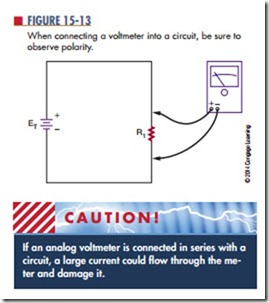Measuring Voltage
Voltage exists between two points; it does not flow through a circuit as current does. Therefore, a voltmeter, used to measure voltage, is connected in parallel with the circuit.
polarity is important with analog meters. The negative terminal of the voltmeter must be connected to the more negative point in the circuit, and the positive terminal to the more positive point in the circuit (Figure 15-13). If the connections are reversed, the pointer deflects toward the left side of the meter, registering no measurement. If this occurs, reverse the meter leads.
A good practice is to remove power from the circuit, connect the voltmeter, and then reapply power. Initially, set the voltmeter for its highest scale. After the voltage is applied to the circuit, set the meter down to the proper scale.
The voltmeter’s internal resistance is connected in parallel with the component being measured. The total resistance of resistors in parallel is always less than that of the smallest resistor. As a result, the voltage read by the voltmeter is smaller than the actual voltage across the component. In most cases, the internal resistance of a voltmeter is high, so the error is small and can be ignored. However, if voltage is being measured in a high-resistance circuit, meter resistance may have a noticeable effect. Some voltmeters are designed with extra-high internal resistance for such purposes.
Currently, the DMM is the best all-around meter available. The voltage ranges have very little loading effect on the circuits being measured. The meter’s internal resistance is typically up to 10 MΩ on its voltage range, compared to a quality analog meter with an internal resistance of 20,000 Ω /V, which would yield 20,000 Ω on its 1 V range.
Questions
1. How is a voltmeter connected to a circuit?
2. What is the recommended practice for connecting a voltmeter to a circuit?
3. What should be done if the voltmeter reads in the reverse direction?
4. What caution must be taken when measuring a high-resistance circuit?
5. Why should a voltmeter never be connected in series in a circuit?
